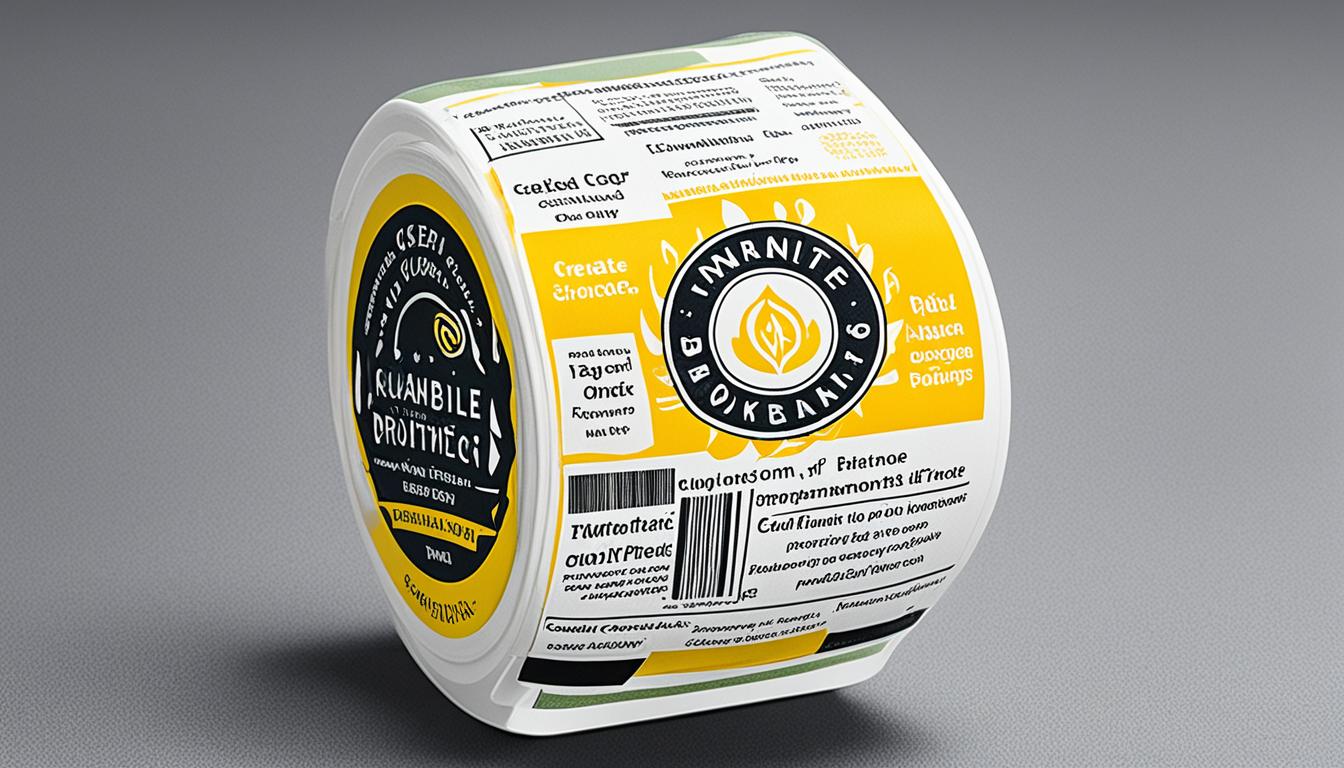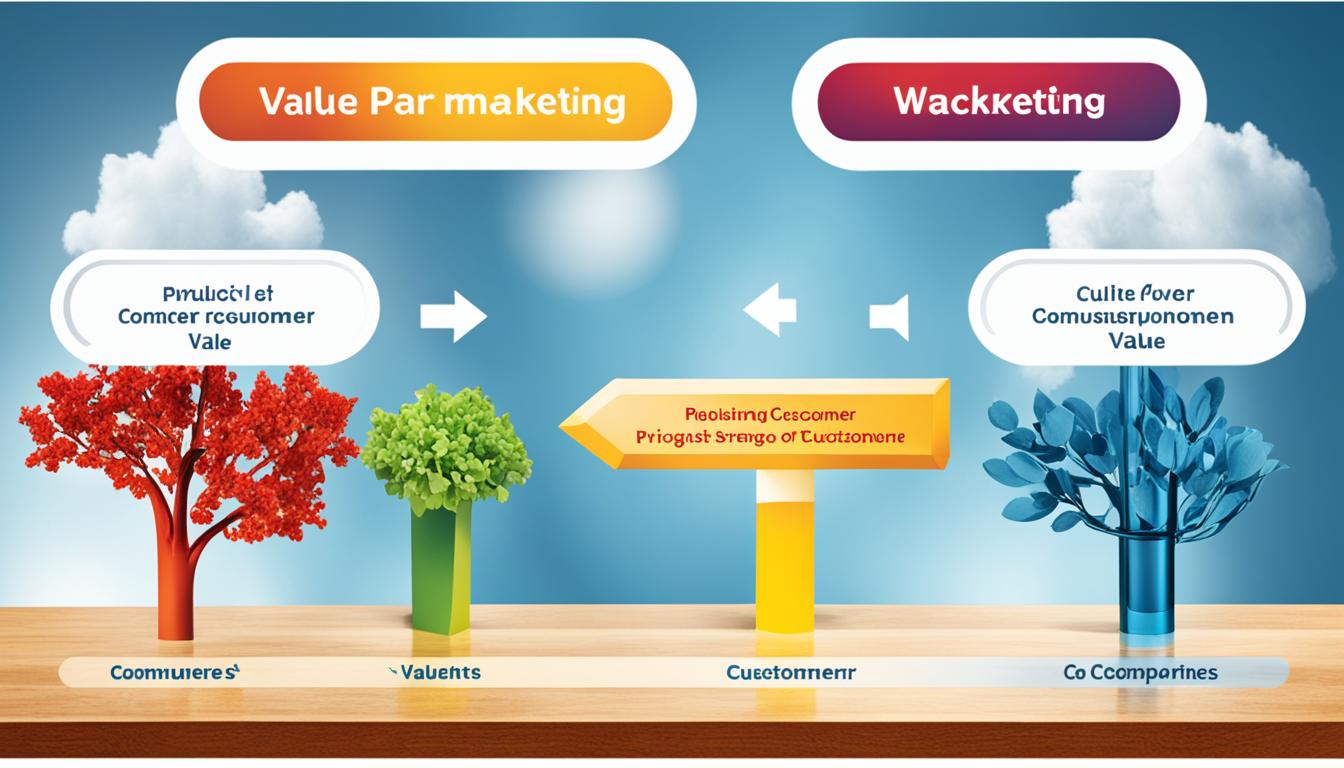Wholesale marketing plays a crucial role in the success of businesses that sell products in bulk to large retailers, wholesalers, and distributors. By adopting a wholesale marketing approach, companies can expand their reach, increase their profits, and secure better deals with suppliers. Leading industry players such as Amazon, Walmart, Target, and Best Buy have successfully implemented wholesale marketing strategies to their advantage.
Key Takeaways:
- Wholesale marketing involves selling products in bulk directly to retailers, wholesalers, and distributors.
- It allows businesses to expand their reach, maximize profits, and negotiate better deals with suppliers.
- Amazon, Walmart, Target, and Best Buy are examples of companies that have successfully employed wholesale marketing strategies.
As we delve deeper into the world of wholesale marketing, we will explore what it entails, various strategies employed, and the benefits it offers to businesses.
What is Wholesale Marketing?
Wholesale marketing is a strategic approach used by businesses to expand their customer base and increase their profit margins. This involves implementing various techniques and strategies to reach a larger audience and increase revenue. Wholesale marketing encompasses direct sales, multi-channel marketing, leveraging relationships with other businesses, and utilizing digital platforms such as social media and search engine optimization.
The ultimate goal of wholesale marketing is to tap into new markets and attract customers who may not be aware of a company’s products or services. Wholesale customers can come from various sources, including potential customers, established wholesalers, and distributors. By utilizing effective wholesale marketing strategies, businesses can enhance their brand visibility, forge valuable partnerships, and drive sales.
Types of Wholesale Marketing Strategies
Implementing effective wholesale marketing strategies is essential for businesses to succeed in the competitive wholesale market. Here are some tried-and-tested techniques that can help wholesalers maximize their reach and boost their sales:
1. Relationship Building
Establishing strong relationships with customers is crucial for wholesale businesses. By building trust and providing personalized support, wholesalers can foster loyalty and encourage repeat purchases. This can be achieved through regular communication, excellent customer service, and timely order fulfillment. Investing time and effort into building relationships can lead to long-term partnerships and increased sales.
2. Digital Marketing
In today’s digital age, having a strong online presence is crucial for wholesale businesses. Utilizing various digital marketing channels such as social media, email marketing, and search engine optimization (SEO) can help wholesalers reach their target audience effectively. By creating engaging content, optimizing their websites for search engines, and leveraging social media platforms, wholesalers can attract potential customers and drive traffic to their online stores.
3. Trade Shows and Industry Events
Participating in trade shows and industry events provides wholesalers with an excellent opportunity to showcase their products and connect with potential customers. By attending these events, wholesalers can gain valuable insights into market trends, meet industry influencers, and build relationships with key decision-makers. Showcasing products at these events can generate leads and lead to fruitful collaborations.
4. Competitive Pricing and Discounts
Offering competitive pricing and attractive discounts is a powerful strategy to attract wholesale customers. By pricing their products competitively and providing volume-based discounts, wholesalers can incentivize customers to choose their products over competitors’. This strategy not only helps attract new customers but also encourages existing customers to continue purchasing from the wholesaler.
5. Upselling and Cross-selling
Wholesalers can increase their sales by implementing upselling and cross-selling techniques. Upselling involves offering customers a higher-priced alternative or additional products that complement their purchase, while cross-selling involves suggesting related products that complement the customer’s existing purchase. By employing these strategies, wholesalers can increase their average order value and maximize their revenue.
| Strategy | Description |
|---|---|
| Relationship Building | Establish strong relationships with customers through personalized support and excellent customer service. |
| Digital Marketing | Utilize social media, email marketing, and SEO to reach target customers effectively. |
| Trade Shows and Industry Events | Participate in industry events to showcase products and connect with potential customers. |
| Competitive Pricing and Discounts | Offer competitive pricing and attractive discounts to incentivize customers. |
| Upselling and Cross-selling | Increase sales by offering higher-priced alternatives or complementary products. |
Benefits of Wholesale Marketing
Wholesale marketing offers numerous benefits to businesses, providing them with advantages that can help drive success:
- Increased Reach: By selling products in bulk to retailers, wholesalers, and distributors, businesses can significantly expand their customer base and reach a larger audience.
- Higher Profits: Wholesale marketing allows businesses to negotiate better deals with suppliers, enabling them to obtain products at lower costs. This, in turn, provides an opportunity to maximize profits and create a competitive advantage.
- Improved Efficiency: By selling in bulk quantities, businesses can streamline their operations and achieve greater efficiency in production, distribution, and logistics.
- Stronger Relationships: Wholesale marketing fosters relationships with retailers, wholesalers, and distributors, leading to long-term partnerships that can drive continuous sales and growth.
- Brand Awareness: When products are sold through wholesale channels, they are often distributed to a wider range of locations, increasing brand visibility and recognition.
Overall, wholesale marketing presents businesses with an effective strategy to expand their reach, boost profits, enhance efficiency, and establish strong industry relationships.
Examples of Wholesale Marketing in India
In the Indian FMCG industry, there are several companies that employ successful wholesale marketing strategies. One example is Metro Cash & Carry, which operates 24 wholesale distribution centers across the country and serves various customers, including small retailers, hotels, corporates, and kirana stores. Metro offers a wide range of products such as fruits, vegetables, groceries, bakery products, and frozen food. This company allows only business customers to purchase from them and provides a customer registration card for access to their products and services.
| Features | Description |
|---|---|
| Number of Wholesale Distribution Centers | 24 |
| Target Customers | Small retailers, hotels, corporates, kirana stores |
| Product Range | Fruits, vegetables, groceries, bakery products, frozen food |
| Purchase Restrictions | Only business customers |
| Customer Registration | Provided for access |
Differences Between Wholesale Marketing and Retail Marketing
When it comes to marketing, wholesalers and retailers have distinct strategies to reach their target audiences. Understanding the differences between wholesale marketing and retail marketing is crucial for businesses in the B2B market.
Target Audience
In wholesale marketing, the primary target audience is other businesses. Wholesalers sell products in bulk quantities to retailers, distributors, and other wholesalers who then sell them to end consumers. On the other hand, retail marketing focuses on attracting individual consumers who purchase products for personal use.
Sales Approach
Wholesale marketing involves selling products in large quantities, often with the goal of catering to the needs of larger businesses. Wholesalers typically offer discounts, volume pricing, and incentives to attract wholesale customers. Retail marketing, on the other hand, focuses on selling products in individual units to consumers who value convenience and personalized experiences.
Marketing Strategies
Wholesale marketing strategies often emphasize building long-term relationships with business customers. These strategies may include attending trade shows, offering personalized service, and providing competitive pricing. Retail marketing strategies, on the other hand, revolve around creating a strong brand presence, utilizing advertising campaigns, and providing an excellent in-store or online shopping experience for individual consumers.
Comparison Table: Wholesale Marketing vs. Retail Marketing
| Aspect | Wholesale Marketing | Retail Marketing |
|---|---|---|
| Target Audience | B2B Customers (Retailers, Distributors, Wholesalers) | Consumers |
| Sales Approach | Selling in Bulk Quantities | Selling in Individual Units |
| Marketing Strategies | Building Relationships, Volume Pricing | Brand Building, Advertising Campaigns |
Understanding the nuances between wholesale marketing and retail marketing is essential for businesses looking to effectively target their desired customers, maximize sales, and cultivate successful partnerships in the B2B market.
Developing a Wholesale Marketing Plan
To develop an effective wholesale marketing plan, businesses need to consider several key factors. These include identifying their target wholesale customers, setting specific and measurable marketing goals, determining appropriate marketing strategies, and allocating a budget accordingly.
Identifying Target Wholesale Customers
The first step in developing a wholesale marketing plan is to identify the target wholesale customers. This involves understanding the industry, product category, and target market. By analyzing these factors, businesses can determine the specific types of wholesale customers they want to target.

Setting Marketing Goals
Once the target wholesale customers are identified, businesses need to establish specific and measurable marketing goals. These goals should align with the overall business objectives and guide the marketing efforts. Examples of wholesale marketing goals may include increasing customer acquisition, boosting sales, expanding market share, or improving brand awareness.
Implementing Marketing Strategies
After defining the marketing goals, businesses must develop and implement appropriate marketing strategies. Some effective wholesale marketing strategies include:
- Developing a strong online presence to reach a wider audience through websites, e-commerce platforms, and social media channels.
- Investing in content marketing to create and share valuable information that engages and educates the target wholesale customers.
- Using social media marketing to connect with potential wholesale customers, share industry updates, and promote products and services.
- Attending trade shows and industry events to network with potential customers and showcase products and services.
- Offering competitive pricing and discounts to attract wholesale customers and provide incentives for repeat purchases.
- Providing excellent customer service to build strong relationships and gain customer loyalty.
- Creating a comprehensive wholesale catalog that showcases the products and services offered, pricing, and ordering information.
Allocating a Marketing Budget
Finally, businesses need to allocate a budget for their wholesale marketing plan. The budget should be based on the desired marketing strategies and goals. It is important to allocate sufficient funds to each marketing strategy to ensure their effective implementation. Regular evaluation and adjustment of the budget may be necessary to optimize the marketing efforts.
By developing a well-planned wholesale marketing strategy, businesses can effectively reach their target wholesale customers, generate more sales, and establish a strong presence in the market.
Identifying Target Wholesale Customers
To effectively identify target wholesale customers, businesses need to take into account several key factors. These include industry, product category, target market, and distribution channels. By carefully considering these factors, businesses can narrow down their focus and tailor their marketing efforts to reach the right wholesale customers.
To begin the process of identifying target wholesale customers, analyzing the existing customer base is crucial. This helps businesses understand their current customer profile and identify any patterns or trends. By doing so, they can gain insights into which industries or product categories their current customers belong to. This information serves as a starting point for identifying potential target wholesale customers.
In addition to analyzing the existing customer base, researching the industry and competitors is essential. This allows businesses to understand the competitive landscape, identify key players in the industry, and gain insights into the target market. By studying competitors’ customer bases and marketing strategies, businesses can gain valuable insights and identify potential areas of opportunity.
Attending trade shows and industry events is another effective way to identify target wholesale customers. These events provide an opportunity to connect with industry professionals, network with potential customers, and showcase products or services. By engaging in conversations and collecting contact information, businesses can establish valuable connections and expand their network.
Using online tools and platforms to search for potential wholesale customers is also recommended. Online directories, industry forums, and professional social media platforms can be valuable resources for finding and connecting with wholesale customers. By using specific search filters, such as industry or location, businesses can narrow down their search and identify potential leads.
Once potential wholesale customers have been identified, it is important to qualify them based on specific criteria. Factors such as product relevance, reputation, financial stability, and distribution network should be taken into consideration. This ensures that businesses are establishing relationships with qualified wholesale customers who align with their business goals and values.
Building relationships with qualified wholesale customers is crucial for successful wholesale marketing. By nurturing these relationships, businesses can establish trust, loyalty, and long-term partnerships. This can be done through effective communication, offering personalized solutions, and providing exceptional customer service.
Marketing Strategies for Wholesale Distribution
Effective wholesaler marketing is essential for wholesale distribution businesses to attract customers and stay competitive in the market. By implementing the right strategies, wholesalers can position themselves strategically, build strong relationships, and create a memorable brand experience. Here are some key marketing strategies for wholesale distribution:
Leverage Warehouse Management Software for Efficient Operations
Investing in warehouse management software can optimize operations, streamline inventory management, and improve overall efficiency. This ensures timely order fulfillment and customer satisfaction, making it easier to meet the demands of wholesale customers.
Build a Retail Network Through Strong Relationships
Establishing strong relationships with retailers and other businesses in the industry can help wholesalers expand their network and reach. By collaborating with retail partners, wholesalers can access more customers and increase their market share.
Offer Attractive Buying Incentives
Wholesalers can attract customers by offering attractive buying incentives such as discounts, bulk purchase deals, free shipping, and flexible payment terms. These incentives encourage wholesale buyers to choose their products over competitors’ offerings.
Position the Business Where the Target Customers Are
Understanding the target customers’ preferences and behaviors is crucial for effective B2B marketing for wholesalers. By positioning the business in locations with high customer traffic or online platforms where the target customers are present, wholesalers can increase their visibility and reach the right audience.
Rigorously Examine Marketing Spend to Ensure Effectiveness
Regularly evaluating the effectiveness of marketing campaigns is important to optimize marketing spend. Wholesalers should analyze marketing metrics, track ROI, and make data-driven decisions to allocate resources efficiently and focus on the most effective marketing channels.
Take Advantage of Competitors’ Weaknesses
By analyzing competitors’ strengths and weaknesses, wholesalers can identify opportunities to differentiate themselves. This could involve offering unique product features, better customer service, or targeted marketing messages that address competitors’ weaknesses.
Create a Memorable Brand Experience
Building a strong brand is crucial for wholesale businesses. Wholesalers can create a memorable brand experience by focusing on aspects such as packaging, branding, website design, and customer service. Consistency in branding across all touchpoints helps wholesalers stand out and establish trust with their customers.
Run an Email List for Customer Engagement
Email marketing is a powerful tool to engage with current and potential wholesale customers. Wholesalers can build an email list by offering exclusive content, industry insights, product updates, and promotional offers. Regularly communicating with wholesale customers helps maintain a strong relationship and encourages repeat business.
Master the Advertising Approach with Targeted Campaigns
Wholesalers should develop targeted advertising campaigns to reach their specific audience. By utilizing demographic data, online advertising platforms, and social media advertising, wholesalers can create customized campaigns that resonate with their target customers and drive sales.
Implementing these marketing strategies can help wholesalers effectively market their products and services to B2B customers, attract new customers, and build a strong position in the competitive wholesale distribution market.

Conclusion
Wholesale marketing is a crucial aspect of running a successful wholesale business. By implementing various marketing strategies, businesses can effectively reach their target wholesale customers, increase sales, reduce costs, build relationships, and establish a strong brand presence.
It is important for wholesalers to continuously evaluate and refine their marketing plans to adapt to changing market trends and customer preferences. By staying proactive and innovative, wholesalers can stay ahead of the competition and achieve long-term success.
By leveraging digital platforms, such as social media and search engine optimization, wholesalers can expand their customer base and attract potential customers who may not be aware of their products and services. Additionally, by offering competitive pricing, discounts, and excellent customer service, wholesalers can build loyalty and trust with their wholesale customers.
To maintain a strong brand presence, wholesalers should invest in creating a memorable brand experience and running targeted marketing campaigns. By staying up-to-date with industry trends and continuously improving their marketing strategies, wholesalers can achieve sustainable growth and success in the wholesale market.
FAQ
What is wholesale marketing?
Wholesale marketing is a type of marketing strategy that involves selling wholesale products directly to large retailers, wholesalers, or distributors in bulk.
What are some examples of companies that utilize wholesale marketing?
Companies such as Amazon, Walmart, Target, and Best Buy are examples of successful companies that have adopted a wholesale marketing approach.
What are the benefits of wholesale marketing?
Wholesale marketing allows businesses to expand their reach, negotiate better deals with suppliers, and maximize their profits by selling products in bulk quantities.
How does wholesale marketing differ from retail marketing?
Wholesale marketing targets businesses and involves selling products in bulk quantities, while retail marketing targets consumers and involves selling products in individual units.
How can businesses develop a wholesale marketing plan?
Businesses should consider their target wholesale customers, marketing goals, strategies, and budget when developing a wholesale marketing plan.
How can businesses identify their target wholesale customers?
Businesses can identify their target wholesale customers by analyzing their existing customer base, researching the industry and competitors, attending trade shows and industry events, and using online tools to search for potential customers.
What are some successful marketing strategies for wholesale distribution?
Successful marketing strategies for wholesale distribution include leveraging technology, building strong relationships, offering incentives, positioning strategically, examining marketing spend, taking advantage of competitors’ weaknesses, creating a memorable brand experience, running an email list for customer engagement, and mastering targeted advertising campaigns.
Can you provide examples of wholesale marketing strategies in India?
One example is Metro Cash & Carry, which operates wholesale distribution centers across India and serves various customers, including small retailers, hotels, corporates, and kirana stores.
What are some key differences between wholesale marketing and retail marketing?
Wholesale marketing targets businesses, while retail marketing targets consumers. Wholesale marketing involves selling products in bulk quantities, while retail marketing involves selling products in individual units.
What is the importance of wholesale marketing for wholesalers?
Wholesale marketing is a crucial aspect of running a successful wholesale business as it helps wholesalers reach their target customers, increase sales, reduce costs, build relationships, and establish a strong brand presence.







